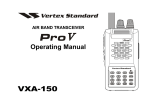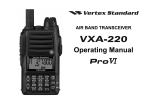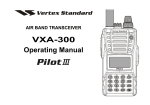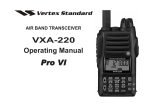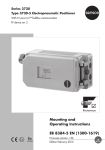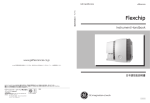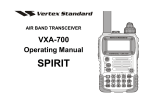Download Vertex Standard VXA-150 Specifications
Transcript
AIR BAND TRANSCEIVER Operating Manual VXA-210 1 2 3 4 5 6 7 8 9 MW 0 F CONTENTS Important Notice! ........................................................... 1 Introduction .................................................................... 2 Controls & Connectors ................................................. 3 Top Panel .............................................................................. 3 Front Panel ........................................................................... 4 LCD Display ........................................................................ 5 Keypad .................................................................................. 6 Left Side ............................................................................... 7 Right Side ............................................................................. 8 Before You Begin ........................................................... 9 Precaution ............................................................................. 9 Battery Installation and Removal ....................................... 9 Battery Charging ................................................................ 10 Low Battery Indication ...................................................... 11 Installing the FBA-25 (option) Alkaline Battery Case .... 11 Operation ...................................................................... 12 Preliminary Steps ............................................................... 12 Operation Quick Start ........................................................ 12 Squelch Adjustment .................................................... 14 Accessing the 121.5 MHz Emergency Frequency ........... 14 Tuning Methods ................................................................. 15 Transmission ...................................................................... 16 Reception of Weather Channel Broadcasts ...................... 16 Monitor Key ....................................................................... 18 ANL (Automatic Noise Limiter) Feature ......................... 18 Temperature Display .......................................................... 19 LOCK Function ................................................................. 19 Receive Battery Saver Setup ............................................. 20 Beep On/Off ....................................................................... 21 Barometric Pressure/Altitude Metering ................... 22 Thermometer Calibration .................................................. 22 Correcting the Atmospheric Pressure Meter (Barometer Offset) .. 23 Correcting the Altimeter setting (Altimeter Offset) ......... 23 How to Measure the Rarometric Pressure or Altitude ..... 24 Weather Sensor Mode ....................................................... 24 Memory Operation ....................................................... 26 Memory Storage ................................................................. 26 Recalling the Memories..................................................... 27 Scanning Operation .................................................... 28 Channel-Skip Scanning ..................................................... 29 Dual Watch Operation ................................................. 30 Priority Dual Watch Operation ................................... 31 VOR Navigation ............................................................ 32 To Select the DVOR Mode ............................................... 33 Flying to a VOR Station .................................................... 34 Entering a Desired Couse .................................................. 36 Position Cross-checking .................................................... 37 Split Operation ................................................................... 38 Field Programming Mode ........................................... 39 Memory Storage into the Book Memory ......................... 39 Menu (“Set”) Mode ...................................................... 40 Menu Listing ...................................................................... 41 Installation of the SU-1 ............................................... 45 Accessories & Options ............................................... 46 Specifications ............................................................... 48 NOTICE There are no user-serviceable points inside this transceiver. All service jobs must be referred to your Authorized Service Center. IMPORTANT NOTICE! FCC RF Exposure Compliance Requirements for Occupational Use Only: This Radio has been tested and complies with the Federal Communications Commission (FCC) RF exposure limits for Occupational Use/Controlled exposure environment. In addition, it complies with the following Standards and Guidelines: r FCC 96-326, Guidelines for Evaluating the Environmental Effects of Radio-Frequency Radiation. r FCC OET Bulletin 65 Edition 97-01 (1997) Supplement C, Evaluating Compliance with FCC Guidelines for Human Exposure to Radio Frequency Electromagnetic Fields. r ANSI/IEEE C95.1-1992, IEEE Standard for Safety Levels with Respect to Human Exposure to Radio Frequency Electromagnetic Fields, 3 kHz to 300 GHz. r ANSI/IEEE C95.3-1992, IEEE Recommended Practice for the Measurement of Potentially Hazardous Electromagnetic Fields - RF and Microwave. ¦ This radio is NOT approved for use by the general population in an uncontrolled environment. This radio is restricted to occupational use, work related operations only where the radio operator must have the knowledge to control its RF exposure conditions. ¦ When transmitting, hold the radio in a vertical position with its microphone 1 to 2 inches (2.5 to 5 cm) away from your mouth and keep the antenna at least 1 inch (2.5 cm) away from your head and body. ¦ The radio must be used with a maximum operating duty cycle not exceeding 50%, in typical Push-toTalk configurations. DO NOT transmit for more than 50% of total radio use time (50% duty cycle). Transmitting more than 50% of the time can cause FCC RF exposure compliance requirements to be exceeded. The radio is transmitting when the red LED on the top of the radio is illuminated. You can cause the radio to transmit by pressing the P-T-T button. ¦ Always use Vertex Standard authorized accessories. VXA-210 PILOT OPERATING MANUAL 1 INTRODUCTION The Vertex Standard VXA-210 Pilot is a compact, stylish, solid hand-held transceiver providing communication (transmit and receive) capability on the International Aircraft Communication Band (“COM” band: 118 ~ 136.975 MHz), and it additionally provides VOR and CDI navigation features on the “NAV” band (108 ~ 117.975 MHz). The VXA-210 includes Temperature display with our exclusive Omni-GlowTM display back-light for minimal degradation of your night vision, NOAA weather band monitoring, 8-character Alpha/Numeric Display, 50 Memory Channels, and 100 “Book Memory” Channels. And the optional Barometric Pressure Unit (SU-1) provides readout of barometric pressure, altitude, and density altitude. We recommend that you read this manual in its entirety, so as to understand the many features of the VXA-210 completely. Keep this manual handy, so you may use it for reference. NOTE: The VXA-210’s VOR and CDI Navigation features are supplemental aids to navigation only, and are not intended to be a substitute for accurate (primary) VOR/CDI or landing service equipment. And also, the Barometric/Altitude features of the optional SU-1 are not designed to be a substitute for accurate, calibrated Barometer or Altimeter devices used for navigation critical to personal safety. Congratulations! You now have at your fingertips a valuable communications tool-a Vertex Standard two-way radio! Rugged, reliable and easy to use, your Vertex Standard radio will keep you in constant touch with your colleagues for years to come, with negligible maintenance down-time. Please take a few minutes to read this manual carefully. The information presented here will allow you to derive maximum performance from your radio, in case questions arise later on. We're glad you joined the Vertex Standard team. Call on us anytime, because communications is our business. Let us help you get your message across. 2 VXA-210 PILOT OPERATING MANUAL CONTROLS & CONNECTORS (TOP PANEL) Antenna Jack This SMA jack accepts the supplied flexible antenna, or another antenna designed to provide 50 W impedance on the Aircraft Communication Band. POWER/VOLUME Knob VOL DIAL Turn this control clockwise to turn the radio on and to increase the volume. Counterclockwise rotation into the click-stop will turn the radio off. BUSY/TX Indicator Lamp This lamp glows green when a signal is being received and red when transmitting. DIAL Selector Knob This 20-position detended rotary switch tunes the operating frequency or selects the memory channels. Pressing this knob downward momentarily selects the tuning methods among the VFO (Variable Frequency Oscillator), MR (Memory Recall), BOOK (Pre-Programmed Memories), and WX (Weather Channel Memories) mode. Note: The WX mode is available in the USA version only. VXA-210 PILOT OPERATING MANUAL 3 CONTROLS & CONNECTORS (FRONT PANEL) LCD (Liquid Crystal Display) The display shows the selected operating conditions as indicated on the next page. Loudspeaker The internal speaker is located in this position. Microphone Speak across this opening in a normal voice level while pressing the PTT switch, to transmit. Keypad Several keys have dual functions. The primary functions are labeled on the key top (activated by simply pressing the key momentarily), while the secondary functions are labeled in yellow above the top edge of the key (activated by pressing the [F] key first, then the indicated key). These functions are described in detail on page 6. Battery Pack Latch 1 2 3 4 5 6 7 8 9 MW 0 F Open this latch for battery removal. 4 VXA-210 PILOT OPERATING MANUAL CONTROLS & CONNECTORS (LCD DISPLAY) This field displays the course heading in degrees. See page 33. This is the Course Deviation Indicator, used during VOR Navigation. See page 32. This icon indicates that the “Book” Memory Bank is in use. See page 15. This indicator confirms that Secondary Key Function is active. See page 6. This icon is the “Low Battery” indicator, which blinks when the battery voltage becomes too low for proper operation. This indicator confirms that this channel will be skipped during scan. See page 29. This icon is used during VOR navigation, to indicate that the displayed information is based on a course from the VOR station. See page 33. These digits provide frequency or alphanumeric information about the channel you are using. This icon is used during VOR navigation, to indicate that the displayed information is based on a course to the VOR station. See page 33. VXA-210 PILOT OPERATING MANUAL This indicator confirms that the A UTOMATIC NOISE L IMITER is activated. See page 18. This indicator confirms that DUAL W ATCH is active. See page 30. This indicator confirms that the “Split” (Duplex) mode is activated during VOR operation. See page 38. 5 CONTROLS & CONNECTORS (KEYPAD) Primary Function (Press Key) Frequency Entry Digit 1 Secondary Function Activates DVOR mode (Press +) Primary Function (Press Key) Frequency Entry Digit 4 Secondary Function Activates Course Deviation Indicator mode (Press +) Primary Function (Press Key) Frequency Entry Digit 7 Frequency Entry Digit 2 Frequency Entry Digit 3 Selects Memory Display Type (page 27) Selects “TO” VOR mode Selects “FROM” VOR mode Locks the Keypad Frequency Entry Digit 5 Frequency Entry Digit 6 Selects Emergency Channel (121.5 MHz) Activates the Altimeter Set function Activates the Sensor Functions None Frequency Entry Digit 8 Frequency Entry Digit 9 Activates Automatic Noise Limiter Allows Skipping of Channel during Scan None Secondary Function Activates Split (Duplex) On/Off Switch for mode Keypad Beeper (page 21) (Press +) Primary Function (Press Key) Secondary Function (Press +) 6 Memory “Write” Command Frequency Entry Digit 0 Activates Scanning Activates “Secondary” Key mode Split-Memory “Write” Command None Activates Dual Watch None VXA-210 PILOT OPERATING MANUAL CONTROLS & CONNECTORS (LEFT SIDE) PTT (PUSH TO TALK) Switch Press this button to transmit when you are operating in the COM band. Release this button to return to the “RECEIVE” mode. See page 16. MONITOR Switch This button may be pressed to “open” the squelch manually, allowing you to listen for very weak signals. Press and hold this button for 2 seconds to “open” the squelch continuously. Press this button again to resume normal (quiet) monitoring. See page 18. LAMP Switch Pressing the LAMP switch momentarily will illuminate the display and keypad for five seconds, after which the back-lighting will automatically turn off. Press and hold this switch for 2 seconds to activate the back-lighting lamp continuously. To turn the lamp off, press this switch again. The LAMP switch may be configured in several ways via the Menu; see page 43 for details. VXA-210 PILOT OPERATING MANUAL 7 CONTROLS & CONNECTORS (RIGHT SIDE) MIC/EAR Jack MIC /SP You may connect the supplied CT-60 Headset Cable or the (optional) MH-44A4B Speaker/Microphone to this jack. Never connect any Speaker/Microphone that is not recommended by the manufacturer. Because these jack connections are unique, using a Speaker/Microphone that is not specified by Vertex Standard may damage the VXA-210. EXT DC Jack EXT DC 8 When an external 12-Volt DC power source is available, you may connect the (optional) E-DC5B External DC Cable here. Do not connect any wire to this jack if that wire is connected directly to a 28-Volt DC source. Connecting the VXA-210 directly to a source which exceeds 15.0 Volts DC will result in damage to the unit. VXA-210 PILOT OPERATING MANUAL BEFORE YOU BEGIN Precautions Battery Installation and Removal r This apparatus is capable of two-way communication on channels used for critical aviation safety communications. Therefore, it is important that this radio be kept away from children or other unauthorized users at all times. r When making DC connections via the (optional) E-DC-5B DC cable, be absolutely certain to observe the proper voltage level and polarity guidelines. Do not connect this radio directly to any 24 ~ 28 Volt DC source, nor to AC power of any kind. Connecting the VXA-210 directly to a source which exceeds 15.0 Volts DC will result in damage to the unit. r Do not dispose of the Ni-Cd Battery Pack in a fire. Do not carry a Ni-Cd Battery Pack in your pocket, where keys or coins could short the terminals. This could create a serious fire/burn danger, and possibly cause damage to the Ni-Cd pack. r Although the VXA-210 is designed to be water resistant, the enclosure is not “waterproof.” Do not allow the radio to become submersed in water, and do not expose it and/or its Ni-Cd Battery Pack to water spray under pressure. ¦ To install the battery, hold the transceiver with your left hand, so your palm is over the speaker and your thumb is on the top of the Belt Clip. Insert the battery pack into the battery compartment on the back of the radio while tilting the Belt Clip outward, then close the Battery Pack Latch until it locks in place with a “Click.” VXA-210 PILOT OPERATING MANUAL the Install B attery Pack EXT DC MIC /SP Tilt the Belt Clip Close the Battery Pack Latch ¦ To remove the battery, turn the radio off and remove any protective cases. Open the Battery Pack Latch on the bottom of the radio, then lift the battery upward and out from the radio while tilting the Belt Clip upward. Do not attempt to open any of the rechargeable Ni-Cd packs, as personal injury or damage to the Ni-Cd pack could occur if a cell or cells become accidentally short-circuited. 9 BEFORE YOU BEGIN Battery Charging It is necessary to fully charge the Ni-Cd battery before its first use. Follow these procedures: ¦ Install the supplied FNB-64 Ni-Cd battery pack onto the transceiver. Ensure that the transceiver is switched off. ¦ Plug the NC-77 into the AC line outlet. ¦ Insert the transceiver and battery pack into the NC-77; the antenna jack should be at the left side when viewing the charger from the front. ¦ If the transceiver and battery pack are inserted correctly, the RED indicator will glow. A fullydischarged pack will be charged completely in 10 hours. Important Notes: r The NC-77 is not designed to power the transceiver for operation (reception or transmission). r Do not leave the charger connected to the transceiver for continuous periods in excess of 24 hours. Long term overcharging can degrade the Ni-Cd battery pack and significantly shorten its useful life. r If using a charger other than the NC-77, or if using a battery pack other than the FNB-64, fol- 10 low the appropriate instructions provided with the charger/battery. Contact your Dealer if you have any doubts about the appropriateness of the particular charger or battery pack you intend to use. 1 2 3 4 5 6 7 8 9 MW 0 F VXA-210/NC-77 VXA-210 PILOT OPERATING MANUAL BEFORE YOU BEGIN Low Battery Indication ¦ As your battery discharges during use, the voltage will gradually become lower. When the battery voltage reaches 6.0 Volts, the “ ” icon will blink on the LCD display, indicating that the battery pack must be recharged before further use. ¦ Avoid recharging Ni-Cd batteries before the “Low Battery” indicator is observed, as this can degrade the charge capacity of your Ni-Cd battery pack. Vertex Standard recommends that you carry an extra, fully-charged pack with you so you will not lose communications capability due to a depleted Ni-Cd battery. This “deep cycling” practice will help to maintain longer overall battery life after many recharging cycles. VXA-210 PILOT OPERATING MANUAL Installing the FBA-25 (option) Alkaline Battery Case The optional FBA-25 Battery Case allows operation of the VXA-210 using six “AA” size Alkaline batteries. When installing batteries, insert the (–) end first, then press in the (+) end so the battery snaps into place. Always replace all six batteries at the same time, paying attention to the polarity indicated inside the case. The FBA-25 must not be used with rechargeable cells. The FBA-25 does not contain the thermal and over-current protection circuits (provided in the “FNB” series of Ni-Cd Battery Packs) required when utilizing Ni-Cd cells. 11 OPERATION 12 Preliminary Steps Operation Quick Start ¦ Install a charged battery pack onto the transceiver, as described previously. ¦ Screw the supplied antenna onto the Antenna jack. Never operate this transceiver without an antenna connected. ¦ If you have an optional Speaker/Microphone or headset, we recommend that it not be connected until you are familiar with the basic operation of the VXA-210. r To turn the radio on, rotate the VOLUME knob out of the click-stop. r After three “initialPress ization” beeps are heard, a channel frequency should appear on the display. If not, press downward (momentarily) on the DIAL selector knob (repeatedly, if necessary) so that “ - VFO - ” appears on the display, followed by a channel frequency. r Directly entering frequencies from the keypad is the easiest method if you know the frequency on which you wish to operate. Just enter the five digits of the frequency to move to that frequency. For example, to set 134.35 MHz, press [1] à [3] à [4] à [3] à [5]. VXA-210 PILOT OPERATING MANUAL OPERATION To set 118.275 MHz, you do not need to press the final “5” in the frequency: [1] à [1] à [8] à [2] à [7]. r You may also turn the top panel’s DIAL selector knob to choose the desired operating frequency. The channel frequency will appear on the LCD. r To change freF quency in 1 MHz + steps, press the [F] key momentarily, then rotate the DIAL selector knob to select the MHz digit desired. Press [F] once more to resume normal channel selection in 25-kHz steps. VXA-210 PILOT OPERATING MANUAL r Rotate the VOLUME knob to set the volume level. If no signal is present, press and hold the MONITOR button for 2 seconds; background noise will now be heard, and you may use this noise to set the VOLUME knob for the desired audio level. Press the MONITOR button momentarily to silence the noise and resume normal (quiet) monitoring. r Press and hold the LAMP button for 2 seconds, to illuminate the display continuously. To disable the illumination, press the LAMP button momentarily. 13 OPERATION r To turn the radio off, turn the VOLUME knob fully counterclockwise into the click stop position. Accessing the 121.5 MHz Emergency Frequency The VXA-210 can quickly access the 121.500 MHz Emergency Frequency. This function can be activated even when the keypad lock function is in use. r To access the Emergency Frequency, press the [ 121.5 ] key momentarily. Squelch Adjustment 1. Press the [F] key momentarily, then press downward on the DIAL selector knob to activate the Menu (“SET”) mode. 2. Rotate the DIAL selector knob to select the Menu Item 01 “SQL.” 3. Press downward on the DIAL selector knob, then rotate the DIAL selector knob to set the squelch threshould (0 to 8) so that the receiver is just silenced. A higher number indicates that a higher signal level is required in order to open the squelch. 4. Press downward on the DIAL selector knob to save your new setting. 5. Press the PTT switch to exit the Menu (“SET”) mode. 14 2 3 5 6 8 9 0 r To exit the Emergency Frequency, press downward on the DIAL selector knob. F Press VXA-210 PILOT OPERATING MANUAL OPERATION Tuning Methods Throughout this manual, you will see references to several different frequency setting methods. Each will be particularly useful in a particular operating situation, and they are described below: ¦ VFO (Variable Frequency Oscillator) The VFO is a “tuning dial” system which allows you to tune through the NAV or COM bands in 25-kHz steps using the DIAL selector, the Keypad, or the scanner. ¦ MR (Memory Recall) The MR (Memory Recall) mode of the VXA210 provides the user with the ability to store and recall as many as 50 channels in the radio’s main memory bank. These memory channels may also be labeled by you with an alpha/numeric name of up to 8 characters in length, to aid in quick identification of the channel. See page 26 for details on creating alpha/numeric labels. ¦ BOOK (Pre-Programmed) Memories The Book memories are pre-programmed, either at the factory or by your Dealer (depending on your country’s requirements), typically including the major COM and NAV band station frequencies used in your area. The Book memories can be changed by the user. See page 39 for details. ¦ WX (Weather Channel) Memories (USA version only) Ten Weather Channels are pre-programmed at the factory. The VXA210 will automatically scan this special bank when it is selected by the user. VFO MR Press WX BOOK ( USA version only) VXA-210 PILOT OPERATING MANUAL 15 OPERATION 16 Transmission Reception of Weather Channel Broadcasts To transmit, press and hold the PTT switch. Speak into the microphone area of the front panel grille in a normal voice level. (USA version only) The VXA-210 can receive VHF Weather Channel broadcasts, which may assist your flight planning. The VXA-210 includes a ten-channel auto-search feature, which simplifies access to Weather Channels when you are in an unfamiliar location. To return to the receive mode, release the PTT switch. r To receive Weather Press Channels, press the DIAL selector knob (repeatedly, if necessary) to select the Weather Channel mode. In the Weather Channel mode, “ - WX -” will appear on the display. r The VXA-210 will now scan quickly through the ten standard Weather Channels, and will stop on the first active station found. r If there are two or more weather channels audible in your area, you may select the alternate channel(s) by pressing the P T T switch. VXA-210 PILOT OPERATING MANUAL OPERATION Pressing the PTT switch re-initiates the scanning process. r If there are no Weather Channels in your area, the scanner will not stop. Press the MONITOR button to stop the scanner. r You can also select Weather Channels manually by rotating the DIAL selector knob. r To confirm the current Weather Channel frequency, press ( )] key the [ momentarily. The display changes to frequency indication. Press the [ ( normal display. 2 3 5 6 8 9 0 r To exit the Weather Channel mode, press the DIAL selector knob momentarily to return to the VFO mode. Press Note: The Weather Channel mode memorizes the last Weather Channel you have used, and will retain this information until the radio is turned off. F )] key again to return to VXA-210 PILOT OPERATING MANUAL 17 OPERATION Monitor Key ANL (Automatic Noise Limiter) Feature When listening to a very weak signal from an aircraft or ground station, you may observe the signal disappearing periodically as the incoming signal strength becomes too weak to override the squelch threshold setting. For reduction of impulse noise, such as that produced by an engine’s ignition system, the ANL feature may prove helpful. To disable the squelch temporarily, press and hold the MONITOR key for 2 seconds on the left side of the radio, just below the PTT button. The squelch will remain open and you should have a better chance of hearing weak signals. r To activate the ANL feature, press the 2 3 [ANL] key momen5 6 tarily. The “ANL” 8 9 icon will appear on F 0 the display, and you should observe a reduction in the ignition noise. r To turn the ANL feature off, repeat the above step; the “ANL” icon will disappear from the display. To return to normal operation, press the MONITOR key momentarily. 18 VXA-210 PILOT OPERATING MANUAL OPERATION Temperature Display LOCK Function The VXA-210 can measure the current temperature. The lock function prevents accidental changes to the frequency setting and the keypad controls. r To display the cur2 3 rent temperature, press [ F ] à [ 6 5 6 (SENSR)]. The dis8 9 play will now indiF 0 cate the current temperature. ( )] key to switch the r Pressing the [ temperatue unit between “Celsius: °C” and “Fahrenheit: °F.” ó r Press the PTT switch to return to the normal operation. If the temperature display is incorrectly, it can be recalibrated. See page 22 for details. VXA-210 PILOT OPERATING MANUAL r To activate the lock 2 3 feature, press [ F ] )]. à[ ( 5 6 r In the LOCK mode, 8 9 the display will show F 0 “ - LOCK -” when you rotate the DIAL selector knob, press the DIAL selector knob, or touch a key on the keypad. r To turn the lock feature off, )] again. press [F] à [ ( r You can still access the 121.500 MHz Emergency Frequency when the LOCK function is on. Simply press the [121.5] key momentarily (this key never locks). Pressing this key also unlocks the radio. 19 OPERATION Receive Battery Saver Setup An important feature of the VXA-210 is its Receive Battery Saver, which “puts the radio to sleep” for a time interval, periodically “waking it up” to check for activity. If somebody is talking on the channel, the VXA-210 will remain in the “active” mode, then resume its “sleep” cycles. This feature significantly reduces quiescent battery drain, and you may change the amount of “sleep” time between activity checks using the Menu System: øABS: Automatic Battery Saver, based on activity on the receiver. The setting of 1:5 will promote the greatest conservation of battery capacity, but the receiver’s response time to incoming calls will be slowed somewhat. Note: This feature does not operate during Scan or Dual Watch. r Press the [F] key, then press the DIAL selector knob to activate the Menu (“SET”) mode. r Rotate the DIAL selector knob to select Menu Item 06 “RSAV.” r Press the DIAL selector knob to enable adjustment of this Menu item. r Rotate the DIAL selector knob to select the desired “duty cycle” (receive:sleep). The selections available are 1:1, 1:2, 1:3, 1:4, 1:5, and ABSø or oFF. The default value is 1:1. r When you have made your selection, press the DIAL selector knob to save the new setting, and then press the PTT key exit to normal operation. 20 VXA-210 PILOT OPERATING MANUAL OPERATION Beep On/Off The VXA-210’s key/button beeper provides convenient audible feedback whenever a button is pressed. Each key and button has a different beep pitch, and each function has a unique beep combination. When you are scanning, the beeper will be heard each time the scanner halts on a busy channel. This may be distracting in some environments; if you want to turn the beeper off (or back on again): r Press [F] à [8 (BEEP )];“05 BEEP” will appear on the LCD. r Press downward on the DIAL selector knob to enable On/ Off selection for the beeper. r Rotate the DIAL selector knob one click to change the display to “BEEP oFF.” r Press downward on the DIAL selector knob to save the new setting. r Press the PTT switch momentarily to exit to normal operation. VXA-210 PILOT OPERATING MANUAL 21 BAROMETRIC PRESSURE/ALTITUDE METERING Thermometer Calibration r Press the [F] key, then press the DIAL selector knob to activate the Menu (“SET”) mode. r Rotate the DIAL selector knob to select Menu Item 14 “TEMP.” r Press the DIAL selector knob to enable adjustment of this Menu item. r Rotate the DIAL selector knob to set the difference (value: in °C) between the VXA-210 display and the calibrated thermometer. For example, if the VXA-210 display shows “24.5 C” and the thermometer (wrongly) indicates “24.0 °C,” set the TEMP offset to “–005”. r Press the DIAL selector knob to save the new setting, and then press the PTT key exit to normal operation. The optional Barometric Pressure Unit (SU-1) brings to the VXA-210 the unique capability of providing readout of the current barometric pressure. This information is the used for calculation of your current altitude, and also used for calculation of your current density Altitude using with the temperature sensor. The Barometric Pressure unit and temperature sensor requires calibration of the “offset” parameters, so that differences in pressure can be used to calculate altitude. This procedure requires that you have a calibrated barometer, calibrated thermometer, and that you know your current altitude. If you are at sea level, of course, the latter parameter requires no research. Notice The optional SU-1 Barometric Pressure Unit for the VXA-210 measures pressure in the immediate vicinity of the transceiver. When using the VXA-210 equipped with the SU-1 in a pressurized cabin of an aircraft, of course, the VXA-210 will not be able to measure outside temperature and pressure, nor display altitude accurately. Please rely on your aircraft’s altimeter for such data. 22 VXA-210 PILOT OPERATING MANUAL BAROMETRIC PRESSURE/ALTITUDE METERING Correcting the Atmospheric Pressure Meter (Barometer Offset) Correcting the Altimeter Setting (Altimeter Offset) r Press the [F] key, then press the DIAL selector knob to activate the Menu (“SET”) mode. r Rotate the DIAL selector knob to select Menu Item 15 “BARO.” r Press the DIAL selector knob to enable adjustment of this Menu item. r Rotate the DIAL selector knob to set the difference (value: in hpa) between the VXA-210 display and the calibrated barometer display. For example, if the VXA-210 display shows “1024 hPA” and calibrated barometer indicates “1029 hpa,” set the Barometer offset to “+005”. r Press the DIAL selector knob to save the new setting, and then press the PTT key exit to normal operation. r Press [F] à [5 (ALT.SET)] to enable the Altimeter Set function. r Enter the proper local barometric pressure value (in “HG”) of the airport directry from the keypad. For example, if the current Barometric Pressure at the airport is “30.05 HG,” press [3 ] à [0] à [0] à [5] on the keypad. r Press the PTT key to save the new setting and exit to normal operation. When the Altimeter function is brought up (by pressing [F] à [6 (SENSR)]), the VXA-210 will now display your correct altitude (+/– tolerance of the SU1). Please remember that the Altitude function of the VXA-210 is not intended to serve as your primary altimeter instrument. Once you have completed the above calibrations, you can confirm the current Temperature, Barometric Pressure, Altitude, or Density Altitude. VXA-210 PILOT OPERATING MANUAL 23 BAROMETRIC PRESSURE/ALTITUDE METERING How to Measure the Barometric Pressure or Altitude r Press [ F ] à [ 6 (SENSR)]; the dis2 3 play will show cur5 6 rent temperature. 8 9 r Rotate the DIAL F 0 knob to select the desired sensor (see next page). )] key to change the measurer Press the [ ( ment units of the current sensor (or On/Off the Pressure Graph). r Press the PTT key exit to normal operation. 24 Weather Sensor Mode The Weather Sensor Mode allows the user to activate only the sensor and display circuits of the VXA-210, for use of the radio solely as a weather monitor. With the “radio” circuits not being activated, battery consumption is reduced significantly. 1. Press and hold in the MONITOR and LAMP keys while turning the radio on, activate the Weather Sensor Mode. 2. Turn the DIAL knob to select the desired sensor among from the “TEMP,” “BARO,” “ALTI,” “GRPH,” and “D.ALT” selection. )] key to change the mea3. Press the [ ( surement units of the current sensor, if desired. 4. Turning the radio off, then on again, will return the VXA-210 to normal operation. VXA-210 PILOT OPERATING MANUAL BAROMETRIC PRESSURE/ALTITUDE METERING - TEMP - - BARO - - ALTI - (Display the current Temperature) (Display the current Barometric Pressure) (Display the current Altitude) ô ô ô Press - D ALT - - GRPH - (Display the Density Altitudeø ) (Display the relative changes in the Barometric pressuer) ø:Density Altitude is pressure altitude corrected for nonstandard temperature. The only time that density altitude will equal pressure altitude is when standard temperatures exist. VXA-210 PILOT OPERATING MANUAL ô Count: every 1/2 hour Resolution: five steps (–, o , –, o , – ) One step: 3 hpa 25 MEMORY OPERATION The VXA-210 provides 50 user-programmable “Main” memories, labeled “CH - 001” through “CH - 050,” and up to 100 pre-programmed memories, designated “Book” Memories. The “ ” icon appears when “Book” Memory Mode is activated. The Main memories and “Book” Memories can be assigned alpha-numeric names of up to eight characters. Memory System Operation The VXA-210’s Main Memory system allows the user to store, label, and recall channel frequencies which you may want to use frequently. You may store VFO frequencies, Book Memory frequencies, and/ or Weather Channel frequencies (USA version only) into the Main Memory system. 26 Memory Storage r Select the desired frequency in the VFO mode, or recall the Book Memory channel or Weather channel to be stored in the Main Memory. r Press and hold the [MW (SPL.W)] key for 2 seconds. The display will indicate “CH - ” and a channel number will blink on the LCD. r Within five seconds of pressing the [ MW (SPL.W)] key, rotate the DIAL selector knob to select the desired memory channel number for storage. In order to prevent writing over memory channels, a bar will appear under the hyphen (located between “CH” and the channel number) to indicate a vacant memory channel. r Now press and hold in the [MW (SPL.W)] key for 2 seconds; you will now see “- - - - - - - - ” on the LCD. To attach an alpha/numeric name (label) to the memory, proceed to the next step; otherwise press and hold [MW (SPL.W)] for 2 seconds to save the entry and exit. r To label a memory with an alpha/numeric name, the next step is to use the DIAL selector knob to select any of the 48 available characters (including letters, numbers, and special symbols). When VXA-210 PILOT OPERATING MANUAL MEMORY OPERATION the desired first character appears, press the DIAL selector knob momentarily to move on to the next character. r Select succeeding characters in the same manner, pressing the DIAL selector knob momentarily after each selection. r After entering the entire name (eight characters maximum), press the [MW (SPL.W)] key for 2 seconds to save all data for the channel and exit. Note: If you have stored a Weather Channel, the “WX - 001 ~ WX - 010” labels utilize the alphanumeric memory, and other labels may not be stored. r Press the DIAL selector knob, repeatedly if necessary, until “MR” (Memory Recall) appears on the display. In the MR mode, you will see “CH -” and the previously selected channel number appearing on the LCD. r Rotate the DIAL selector knob to select the desired memory channel. r You may change the title structure of the Memory display type among: 1. Channel Indication (sequential Channel Number, e.g. CH - 001, CH - 002, etc.); 2. Frequency Indication (e.g. 122.500); or 3. Alphanumeric Label (e.g. LAX FSS). r To change the Memory display title, press the [ ( )] key repeatedly, if necessary, until you get the desired display title structure. r To exit the Memory mode, press the DIAL selector knob momentarily to return to the VFO mode. Alpha-tag Charactors 0 1 2 3 4 5 6 7 8 9 A B C D E F G H I J K L M N O P Q R S T U V W X Y Z < > + Û / D µ S | - - Recalling the Memories VXA-210 PILOT OPERATING MANUAL Note: In either the “MR” or the “Book” Memory mode, you can change memory channels in 10 channel steps: press the [F] key momentarily, then rotate the DIAL selector knob. The “ ” icon will show at the right edge of the display when the 10 channel step tuning mode is active. Press the [F] key once more to resume normal channel selection in 1 channel steps. 27 SCANNING OPERATION The VXA-210 allows you to scan automatically in the VFOø 1 , Main Memory, “Book” Memory, or Weather Channelø2 modes. It pauses on signals encountered, so you can talk to the station(s) on that frequency, if you like. ø1: In the VFO mode, the automatic scanner is only available in the COM band (118.000 - 136.975 MHz); when the scanner reaches the uppermost frequency in the COM band, it will revert to the bottom end of the COM band and repeat the scanning process until you cancel the scanning process. ø2: USA version only. If you wish to scan in the NAV band (108.000 - 117.975 MHz), you can do so manually, as described at the right. Scanning operation is basically the same in each of the above modes. r Press the [SCAN (DW)] key momentarily to start the automatic scanner upward (toward a higher frequency or a higher channel number). r When the scanner encounters a signal, scanning pauses and the radio remains on that channel until one second after the signal disappears, after which scanning will resume. 28 r While the scanner remains paused on a frequency, the decimal point of the frequency display blinks. The display will be illuminated unless the Scan Lamp Feature is turned off. r To change the scan direction, turn the DIAL selector knob one click in the opposite direction. r To stop the automatic scanner, press the PTT switch or the DIAL selector knob momentarily. You may also press [SCAN (DW)] key again. The VXA-210’s automatic scanner is not operational in the NAV band (108.000 - 117.975 MHz), because the NAV stations (ILS, etc.) transmit constantly (thereby causing the scanner to stop repeatedly). However, you can scan manually in the NAV band, per the following procedure: r Press and hold the [SCAN (DW)] key to start the manual scanner. Scanning will continue as long as the key is depressed. r Release the [ SCAN ( DW )] key to stop the manual scanner immediately. Note: When scanning upward in frequency, when the frequency reaches the COM Band (118.000 - 136.975 MHz) via manual scanning, The VXA-210 will switch to the automatic scanner mode. VXA-210 PILOT OPERATING MANUAL SCANNING OPERATION Channel-Skip Scanning Continuous-carrier stations like ATIS (Automatic Terminal Information Service) or Weather Broadcast stations inhibit scanner operation. Since these stations are always active, the scanner will be halted repeatedly on their channels. Such channels can be set to be “skipped” during Memory scanning (MR, Book or WX modes), if you like, so as not to interfere with automatic channel scanning: r Recall the Memory Channel to be skipped during scanning. r Press [F] à [9 (SKIP)]. The “t” icon will appear in the lower right corner, indicating that the channel is to be ignored during scanning. VXA-210 PILOT OPERATING MANUAL r You can also designate a channel to be skipped while scanning. When the receiver is halted on a channel that you wish to skip, press and hold the [SCAN (DW)] key for 2 seconds (the “t” icon will appear next to the channel to be skipped). r Later, to re-enable the memory channel for scanning, repeat the first two steps. The “t” icon will disappear by the channel you have just reenabled. Note: A memory set to be “skipped” is still accessible for manual memory selection using the DIAL selector knob. 29 DUAL WATCH OPERATION The Dual Watch feature automatically checks for activity on a “priority” channelø while you are operating on another channel. During Dual Watch operation, the current channel and the Priority channel will each be polled for a 500 ms interval, as the VXA210 looks for activity on each channel. r To start Dual Watch, press [F] à [SCAN (DW)]. The “DW” icon will appear on the display. r While receiving on the “current” channel (not the Priority channel), you may push the PTT switch at any time to transmit on that channel. r When a signal is received on the Priority channel, operation immediately shifts to the Priority channel, the “DW” icon will blink, and the display will become illuminated. 30 While receiving on the priority channel, if you momentarily press the PTT switch, Dual Watch will be disabled. You may then transmit on the Priority Channel. r To stop Dual Watch, press [F] à [SCAN (DW)]. r If you wish, you may use both the Dual Watch and Scan features simultaneously. To do this, start the Dual Watch first, then start the Scanner. ø The “Priority” Channel is defined as the last-used Memory Channel (when using the VFO mode) or Memory Channel 1 (when using the Main Memory or Book Memory modes). VXA-210 PILOT OPERATING MANUAL PRIORITY DUAL WATCH OPERATION Similar to Dual Watch operation (described on previous page), Priority Dual Watch is an enhanced version which includes the following additional features: l The receiving time interval (ratio) between the current channel and the Priority channel may be customized via the Menu Item “PRTM.” See page 43 for details. l Irrespective of which channel is currently being received, when the PTT button is pushed transmission will always occur on the Priority channel. Before initiating Priority Dual Watch, Menu Item 10 “DWMD” must be set to the “Priority” mode (instead of “Dual Watch”). See page 43 for details. VXA-210 PILOT OPERATING MANUAL r To start Priority Dual Watch, press [F] à [SCAN (DW)]. The “DW” icon will appear on the display. r While receiving on the “current” (non-Priority) channel, pressing the PTT button once causes the radio to switch to the Priority channel and cancels Dual Watch. Press the PTT button again to transmit on the Priority channel. r When a signal is received on the Priority channel, reception immediately shifts to the Priority channel, the “DW” icon will blink, and the display will become illuminated unless the Scan Lamp Feature is turned off. While receiving on the priority channel, if you momentarily press the PTT switch, Priority Dual Watch will be disabled. You may then transmit on the Priority Channel. r To stop Priority Dual Watch, press [F] à [SCAN (DW)]. 31 VOR NAVIGATION General VOR Equipment 0 COURSE Indicator 30 60 30 0 0 33 COURSE Deviation Needle 0 24 FROM 21 0 OBS COM BAND (118.000 - 136.975 MHz) 12 0 TWO-Degree Deviation Marks 180 “TO”-“FROM” Flag Indicator 0 15 NAV BAND (108.000 - 117.975 MHz) DVOR MODE CDI MODE COURSE Indicator COURSE Deviation Needle ž • “TO”-“FROM” Flag Indicator OVERFLOW Indicator 32 VXA-210 PILOT OPERATING MANUAL VOR NAVIGATION To Select the DVOR Mode r When entering the NAV band (108.000 - 117.975 MHz), the VXA-210 selects the DVOR mode automatically. The “COURSE INDICATOR” field will appear at the upper left corner on the display, and the “TO” or “FROM” indicator will appear above the frequency display on the display. Note: The “COURSE INDICATOR” indicates “ - - - ” when either your aircraft is too far away from the VOR station or the frequency is not correctly set to that of the VOR station. Conversely, the “COURSE INDICATOR” will indicate “loc” when a localizer signal is being received. r The “TO” or “FROM” flag indicators indicate whether the VOR navigation information is based on a course leading to the VOR station or leading away from the VOR station. r To change the flag from “TO” to “FROM” or vice versa, press the [F] à [3 (FROM)] or [2 (TO)] key, respectively. r The small “C OURSE I NDICATOR ” and “TO/ FROM” flag indicators may be toggled to the larger “frequency” portion of the display. To do )] key for 2 this, press and hold in the [ ( seconds to toggle to the larger display area. Press VXA-210 PILOT OPERATING MANUAL )] key momentarily again to return the [ ( to the smaller displays. COURSE Indicator “TO”-“FROM” Flag Indicator F 2 F 3 (for 2 seconds) (momentarily) 33 VOR NAVIGATION Flying to a VOR Station The Aircraft is “ON COURSE” The VXA-210 can indicate the deviation from the direct course to a VOR station. r Select a VOR station on your aeronautical chart and turn the DIAL selector knob (or enter the frequency directly with the keypad) to the frequency of the VOR station. r To indicate the deviation between your current flight path and the desired course, press [F] à [4 (CDI)] to change to the CDI (Course Deviation Indicator) mode. The “COURSE DEVIATION ARROW” will appear above the frequency field on the display when your aircraft is off the direct course to the VOR station. r When your aircraft is off course to the right, the Course Deviation Arrow display will show bars to the left side of the diamond (“ | | ¯ ”). When your aircraft is off course to the left, the Course Deviation Arrow display will show bars to the right side of the diamond (“ ¯ | | ”). Correct your course until no bars appear on either side of the CDI “diamond” (only “ ¯ ” will be visible when the heading is correct). r To return to the DVOR mode, press [F] à [1 (DVOR)]. 34 OFF COURSE to the “right” 6 degrees OFF COURSE to the “left” 6 degrees VXA-210 PILOT OPERATING MANUAL VOR NAVIGATION The Aircraft is “ON COURSE” 0° VOR (TAC) Los Angeles LAX - 113.600MHz 310° 320° 330° 340° 350° N 10° 20° 30° 300° 40° 290° 50° 280° 60° 270° 70° 260° 80° 250° VOR Station 240° De sire cra Air The Aircraft is “OFF COURSE” o dC e ft H 230° e u rs ad in g5 90° 100° 110° 220° 0° 210° 200° 190° 180° 170 160 150° ° ° 140° 120° 130° 0° VOR (TAC) Los Angeles 320° LAX - 113.600MHz 330° 340° 350° N 10° 310° 300° 20° 40° 50° 280° 60° 270° 70° 260° din He a raft ur se) c r i o A se of f c (6 ° n c our F lo w VXA-210 PILOT OPERATING MANUAL 80° 250° VOR Station 240° ld b ou t s h 0° f a 5 cr Air d in g he a 230° e Magnetic North 30° 290° ° g 56 Magnetic North 220° 210° 200° 90° 100° 110° 190° 180° 170° 160° 150° 140° 120° 130° 35 VOR NAVIGATION Entering a Desired Course The VXA-210 can also be configured to indicate the deviation from the desired course, not only the deviation from the path to the VOR station. r Set the frequency to the desired VOR station. r To change the “TO” or “FROM” flag to “TO”, if it is not in that mode already. r Press [F] à [4 (CDI)] key to change to the CDI mode. r Set the desired course to the VOR station using the DIAL selector knob or keypad (three digits input; e.g. 47°, press [0] à [4] à [7]). Note 1: The (“ | | ¯”) or (“ ¯ | | ”) indication will appear on the display when your aircraft is off the desired course. Note 2: When your heading is correct, the ABCS function may be more useful than the course input option. r The COURSE DEVIATION ARROW points to the right when your aircraft is off course to the left, and it points to the left when your aircraft is off course to the right. Note 1: To get back on course, fly right more than the number of degrees indicated by the COURSE DEVIATION ARROW. 36 Note 2: If the overflow indicator “u” appears on the right side, select a heading plus 10 degrees to the desired course; if the overflow indicator “t” appears on the left side, select a heading minus 10 degrees. ABCS Mode In the CDI mode, the Auto Bearing Center System (ABCS) adds or subtracts the number of degrees indicated by the CDI from the Omni Bearing Selector (OBS). VXA-210 PILOT OPERATING MANUAL VOR NAVIGATION Position Cross-checking r Select two VOR stations on your aeronautical chart. r Set the frequency of one of the VOR stations in the DVOR mode. The course indicator will show the course deviation from the VOR radial. Note the radial you currently are on. r Now set the frequency of the other VOR station in the DVOR mode. Note the radial from the station you are on. r Extend the radials from each VOR station on the chart. Your aircraft is located at the point where the lines intersect. Cross-checking Position 0° 310° 300° 320° 330° 340° 350° 0° 10° 20° 310° 300° 30° 40° 290° N 50° 280° 60° 270° Magnetic North 260° 80° 250° 220° 210° 200° 90° 120° 190° 180° 170° 160° 150° 140° 130° 30° 40° VOR ( TAC) Los Angeles LAX - 113.600MHz VXA-210 PILOT OPERATING MANUAL N 50° 60° Magnetic North 70° 80° VOR Station 240° 100° 110° 20° 270° 70° 230° 10° 280° 250° VOR Station 330° 340° 350° 290° 260° 240° 320° 230° 90° 100° 110° 220° 210° 200° 190° 180° 170° 160° 150° 140° 120° 130° VOR ( TAC) Long Beach SLI - 115.700MHz 37 VOR NAVIGATION Split Operation The split operation feature allows you to transmit a call to a Flight Service Station using the COM band frequencies, while receiving a VOR station (in the NAV band). VOR stations equipped with this capability typically are shown, on navigation charts, with the voice calling frequency in parenthesis above the navigation frequency. Programming a Transmit Frequency r Press the DIAL selector knob, repeatedly if necessary, to select the VFO mode. r Set a NAV band (108.000 - 117.975 MHz) frequency using the DIAL selector knob or keypad. r Press [F] à [MW (SPL.W)]. The “SPL” icon will blink, and the transmit frequency will appear on the display. r Now set your radio’s transmit frequency, where the Flight Service Station will be listening for calls, using the DIAL selector knob or keypad. r Press and hold in the [MW (SPL.W)] key for 2 seconds to save the transmit frequency and return to the NAV band frequency. Note: You have now stored the separate transmit frequency, but you have not yet activated the split-frequency function; go on to the next section. 38 Operating in the Split Mode r It is assumed that you have already set the desired VOR station’s frequencies (in the NAV band) per the above instructions. r Press [F] à [7 (SPL)] to turn on the “Split” function. The “SPL” icon will appear on the display. r Press and hold in the PTT switch to transmit on the split transmit frequency. r Release the PTT switch to return to the receive mode. r To disable the “Split” function, press [F] à [7 (SPL)] again. Note: A split frequency can be programmed into each memory channel independently. Set a transmit frequency before programming the memory channel, if desired. The split function on/off setting can also be programmed into a memory channel. VXA-210 PILOT OPERATING MANUAL FIELD PROGRAMMING MODE The VXA-210’s Book Memories also allow the user to store, label, and recall channel frequencies which you may want to use frequently while the VXA-210 is in the Field Programming mode. Memory Storage into the Book Memory r Press and hold the PTT and LAMP switches while turning the radio on, to activate the Field Programming Mode. r Select the desired frequency to be stored in the Book Memory. r Press and hold the [MW(SPL.W)] key for 2 seconds. The display will indicate “BOOK - ” and a channel number will blink on the LCD. r Within five seconds of pressing the [MW(SPL.W)] key, rotate the DIAL selector knob to select the desired memory channel number for storage. r Now press and hold in the [MW(SPL.W)] key for 2 seconds; you will now see “- - - - - - - - ” on the LCD. To attach an alpha/numeric name (label) to the memory, proceed to the next step; otherwise press and hold the [MW(SPL.W)] key for 2 seconds to save the entry and exit. VXA-210 PILOT OPERATING MANUAL r To label a memory with an alpha/numeric name, the next step is to use the DIAL selector knob to select any of the 48 available characters (including letters, numbers, and special symbols). When the desired first character appears, press down on the DIAL selector knob momentarily to move on to the next character. r Select succeeding characters in the same manner, pressing down on the DIAL selector knob momentarily after each selection. r After entering the entire name (eight characters maximum), press the [MW(SPL.W)] key for 2 seconds to save all data for the channel. r Repeat this procedure to store additional frequencies into the Book Memory section, as desired. r Turn the radio off, then turn the radio back on again to begin normal operation. 39 MENU (“SET”) MODE The Menu system allows certain aspects of your radio’s configuration to be customized for your personal operating convenience. We do not recommend that any of the default settings be changed, however, until you are thoroughly familiar with the operation of the VXA-210. 4. Rotate the DIAL selector knob to change the setting of the item (ON to OFF, etc.). 1. Press the [F] key, then press the DIAL selector knob to activate the Menu (“SET”) mode. 5. Press the DIAL selector knob to save your new setting. 6. If you need to change more than one Menu item, repeat steps 2 - 5. 7. Press the PTT switch to exit the Menu (“SET”) mode. F + Press 2. Rotate the DIAL selector knob to select the Menu item (feature) you wish to view and/or modify. 3. Once you have selected the desired Menu Item, press the DIAL selector knob once to view the current setting for the item. 40 Press Press VXA-210 PILOT OPERATING MANUAL MENU (“SET”) MODE MENU Listing 01 [SQL] A listing of the Menu items available via the SET mode may be found below. Function: Squelch Level Setting Available Values: 0 ~ 8 Default Setting: 2 Select a setting for this Menu item which just silences the receiver when no signal is present. Use the lowest setting which will keep the receiver quiet between incoming transmissions. Menu No. 01 02 03 04 05 Menu Item SQL MCLR RESM SCNL BEEP Function SQLSquelch Level Setting Memory Channel Clear Scan-Resume Mode Setting Scan Lamp On/Off Keypad Beeper On/Off 06 RSAV Receiver Battery Saver 07 LAMP 08 SFT LCD Illumination Mode CPU Clock Shift 09 PRTM Priority Checking Time Select the 10 DWMD Dual Watch/Priority Function 11 POBP Select the Power on Beep 12 IMIC Internal Microphone On/Off 13 EMRG Emergency Channel On/Off Correcting the 14 TEMP Temperature setting Correcting the 15 BARO Atmospheric pressure Available Values 0~8 – CAR/5 on/oFF on/oFF oFF/ABS/ 1:1 ~ 1:5 KEY/TGL/5 on/oFF 05/10/15/ 20/25/30 KEY oFF 15 (1.5 sec) Function: Memory Channel Clear (“MR” memory only) To Clear a Memory channel: DW/PRI DW 0/1/2/3 on/oFF on/oFF –12.7 ~ +12.7 °C –127 ~ +127 hpa 1 oFF on 1. Select the Menu Item MCLR. 2. Press the DIAL selector knob, then rotate the DIAL selector knob to recall the memory channel to be erased (“MCLR xx” will appear on the display). 3. Press the DIAL selector knob to clear the Memory channel (Memory channel number will disappear). Default 2 – CAR on on 1:1 0 °C 0 hpa 02 [MCLR] Important Notice: An “erased” channel cannot be restored, and “CH - 001” cannot be erased, as it is used for “Priority Channel” operation. VXA-210 PILOT OPERATING MANUAL 41 MENU (“SET”) MODE 03 [RESM] 05 [BEEP] Function: Scan-Resume Mode Setting Available Values: CAR/5 Default Setting: CAR In the “CAR” (Carrier Drop) mode, the scanner will remain halted for as long as there is a carrier present on the channel; after the carrier drops at the end of the other station’s transmission, the scanning will resume. In the “5” (5-Second Pause) mode, the scanner will halt for five seconds only, after which scanning will resume (whether or not the other station is still transmitting). Function: Keypad Beeper On/Off Available Values: on/oFF Default Setting: on If you do a lot of scanning, you may wish to set this Menu item to “oFF,” as the Beeper will be heard each time the scanner pauses. 04 [SCNL] Function: Scan Lamp On/Off (while paused) Available Values: on/oFF Default Setting: on If you set this function to “on,” the lamp will be illuminated whenever the scanner pauses. The lamp will go off automatically when scanning resumes. 42 06 [RSAV] Function: Receive Battery Saver Available Values: 1:1 ~ 1:5/oFF/ABSø Default Setting: 1:1 The setting of 1:5 will promote the greatest conservation of battery capacity, but the receiver’s response time to incoming calls will be slowed somewhat. øABS: Automatic Battery Saver, based on activity on the receiver. Note: This feature does not operate during Scan or Dual Watch. VXA-210 PILOT OPERATING MANUAL MENU (“SET”) MODE 07 [LAMP] 10 [DWMD] Function: Display and Keypad Illumination Mode Available Values: KEY/TGL/5 Default Setting: KEY In the “KEY” mode, the lamp will be activated for 5 seconds when any front panel key is pressed. In the “TGL” mode, the LAMP switch toggles the lamp on and off. In the “5” mode, the LAMP switch activates the lamp for 5 seconds. Function: Select the Dual Watch/Priority Function Available Values: DW/PRI Default Setting: DW In the DW mode, the VXA-210 will activate the Dual Watch feature when you press [F] à [SCAN (DW)]. In the PRI mode, the VXA-210 will activate the Priority feature when you press [F] à [SCAN (DW)]. 08 [SFT] Function: CPU Clock Shift Available Values: on/oFF Default Setting: oFF This function is only used to move a spurious response “birdie” should it fall on a desired frequency. Consult your Yaesu dealer for details regarding this function. 09 [PRTM] Function: Priority Checking Time Available Values: 05/10/15/20/25/30 (x0.1 sec) Default Setting: 15 (1.5 seconds) This Menu item allows you to define how often the Priority Channel will be checked for activity. Note: The Dual Watch Polling time is 500 mS (fixed). VXA-210 PILOT OPERATING MANUAL 11 [POBP] Function: Select the Power on Beep Available Values: 0/1/2/3 Default Setting: 1 12 [IMIC] Function: Internal Microphone On/Off Available Values: on/oFF Default Setting: oFF This controls the status of the radio’s internal microphone when an external microphone (such as the MH44A4B Speaker Microphone or an aviation headset connected via the CT-60 Headset Cable) is in use. In most applications, set 12 [IMIC] to “oFF” for proper operation (this disables the internal microphone). The internal microphone will still function normally when the external microphone is disconnected. 43 MENU (“SET”) MODE 44 13 [EMRG] 14 [TEMP] Function: Emergency channel On/Off Available Values: on/oFF Default Setting: on This controls the operation of the Emergency [121.5] key. When set to “oFF,” this key will not function. You can still use the frequency 121.5 MHz either by entering it on the keypad in the VFO mode, or by recalling it on a previously-stored memory channel. Function: Correcting the Thermometer setting Available Values: –12.7 ~ +12.7 °C Default Setting: 0 °C This allows you to calibrate the internal thermometer with a known-to be-accurate source. 15 [BARO] Function: Correcting the atomspheric pressure Available Values: –127 ~ +127 hpa Default Setting: 0 hpa This allows you to caliblate the Barometer in the optional SU-1 Sensor Unit with a known-to be-accurate source. VXA-210 PILOT OPERATING MANUAL INSTALLATION OF THE SU-1 1. Make sure that the transceiver is off. Remove the hard or soft case, if used. 2. Remove the two screws affixing the belt clip and remove the belt clip, then remove the battery pack. 3. Locate the connector for the SU-1 under the “Caution” label in the battery compartment on the back of the radio, just carefully peel off the “Caution” label. 4. Remove the small Rubber Cushion from the “Caution” label. Keep this Rubber Cushion for future use, because this Rubber Cushion must be replaced on the connector board of the transceiver if you remove the SU-1 from the transceiver. We recommend that this Rubber Cushion be put on the bottom of the SU-1. 5. Align the connector on the SU-1 with the transceiver’s connector and gently press the unit into place. 6. Affix the “Caution” label, and replace the battery and the belt clip. 7. Installation is now complete. Important Note The Barometric pressure/Altitude feature of the optional SU-1 are designed to be supplemental aids for the information of the user, and are not intended to be a substitute for accurate, calibrated Barometer or Altimeter devices used for navigation critical to personal safety. VERTEX STANDARD CO., LTD. MADE IN JAPAN VERTEX STANDARD CO., LTD. MADE IN JAPAN VERTEX STANDARD CO., LTD. MADE IN JAPAN VERTEX STANDARD CO., LTD. MADE IN JAPAN FCC ID:K66VXA-200 CANADA: ÛÛÛÛÛÛÛÛÛ FCC ID:K66VXA-200 CANADA:ÛÛÛÛÛÛÛÛÛ FCC ID:K66VXA-200 CANADA:ÛÛÛÛÛÛÛÛÛ FCC ID:K66VXA-200 CANADA:ÛÛÛÛÛÛÛÛÛ ÛÛÛÛÛÛ ÛÛÛÛÛÛ ÛÛÛÛÛÛ ÛÛÛÛÛÛ 4909969000000 4909969000000 4909969000000 4909969000000 SER NO. 00000000 SER NO. 00000000 SER NO. 00000000 SER NO. 00000000 CAUTION Device restricted to occupational use to satisfy FCC RF exposure compliance. See owner's manual for specific operating requirement. Peel off the CAUTION Label CAUTION Device restricted to occupational use to satisfy FCC RF exposure compliance. See owner's manual for specific operating requirement. Connector VXA-210 PILOT OPERATING MANUAL Press the SU-1 Affix the CAUTION Label 45 ACCESSORIES & OPTIONS Supplied Accessories Ni-Cd Battery Pack (7.2V, 700mAh) Overnight Desktop Charger Helical Antenna Headset Cable Operating Manual Warranty Card Available Options FNB-64 ø NC-77B/C/U ATV-7 CT-60 ø: “B” suffix is for use with 120 VAC, “C” suffix is for use with 230-240 VAC, or “U” suffix is for use with 230 VAC. MH-44A4B FNB-V57 FBA-25 VAC-800 E-DC-5B SU-1 CN-3 Speaker Microphone Ni-Cd Battery Pack (7.2V, 1100mAh) Alkaline Battery Case Desktop Rapid Charger External Power Cable Barometric Pressure Sensor Unit Antenna Adapter (SMA to BNC) Availability of accessories may vary. Some accessories are supplied as standard per local requirements, while others may be unavailable in some regions. Consult your Vertex Standard Dealer for details regarding these and any newly-available options. Connection of any non-Vertex Standard-approved accessory, should it cause damage, may void the Limited Warranty on this apparatus. 46 VXA-210 PILOT OPERATING MANUAL ACCESSORIES & OPTIONS á External Antenna Headset (not supplied) CN-3 Antenna Adapter (Option) CT-60 Headset Cable 1 2 4 5 3 6 7 8 9 MW 0 F E-DC-5B External Power Cable (Option) VXA-210 PILOT OPERATING MANUAL PTT Switch (not supplied) An external PTT switch is required for use with an aviation headset 47 SPECIFICATIONS General Frequency Range: TX: 118.000 - 136.975 MHz, RX: 108.000 - 136.975 MHz, Weather Channels (WX-01 - WX-10: USA version only) Channel Spacing: 25 kHz Emission Type: TX: AM, RX: AM & FM (FM: for receiving the Weather Channels, USA version only) Supply Voltage: 6.0 - 15.0 VDC Current Consumption (approx.): 10 µA (power off), 30 mA (battery saver on, saver ratio 1:5) 65 mA (squelch on), 190 mA (receive), 1 A (transmit 1.5 W Carrier) Temperature Range: +14 °F to + 140 °F (–10 °C to +60 °C) Case Size (WxHxD): 2.3 x 4.3 x 1.2 inch (58 x 109 x 30 mm) w/FNB-64 Weight (approx.): 12.2 oz (345 grams) with FNB-64, antenna, and belt clip Receiver Circuit Type: IFs: Sensitivity: Selectivity: Adjacent CH. Selectivity: AF Output (@7.2 V): Double-conversion superheterodyne 35.4 MHz & 450 kHz <0.8 µV (for 6 dB S/N with 1 kHz, 30 % modulation) >8 kHz/–6 dB <25 kHz/–60 dB 0.4 W @ 8 Ohms, 10 % THD Transmitter Power Output (@ 7.2 V): Frequency Stability: Modulation System: Spurious Emission: Int. Microphone Type: Ext. Mic. Impedance: 48 5 W (PEP), 1.5 W (Carrier Power) Better than ±10 ppm (+14 °F to + 140 °F [–10 °C to +60 °C]) Low Level Amplitude Modulation >60 dB below carrier Condenser 150 Ohms Specifications are subject to change without notice or obligation. VXA-210 PILOT OPERATING MANUAL IN CASE OF DIFFICULTY Most operational difficulties can be solved by your Vertex Avionics dealer. Please contact your dealer first for advice and assistance. r If the dealer is unable to assist you, you may contact us at Vertex Standard USA. We can be reached by telephone at (562) 404-2700 (ask the operator for Avionics Product Support). r If your radio requires repair, it must be sent to Vertex Standard USA. Please note the following: r A Return Authorization is NOT required for repairs, either in or out of warranty. There is no need to contact us before sending a radio for repair. r Please enclose a note describing the problem(s) with the radio, your name and shipping address (no P.O. Box numbers), and a telephone number at which we can reach you during business hours. r Please also enclose a copy of your purchase receipt to establish the warranty date. Radio mainframes are warranted for three years. Accessory r r items (batteries, antennas, chargers, etc.) are warranted for one year. Repair turnaround averages about 7 to 10 working days in our shop, excluding time in shipping. This time will vary, based on our current workload. We can provide repair estimates upon your request. There is no additional charge for the estimate if you authorize the repair. If you decline the repair after requesting an estimate, an estimate fee equal to our current schedule for 1/2 hour of labor will be charged. We return ship warranty repairs via UPS ORANGE (“3 Day Select”) service at our expense. Non-warranty repairs are returned via UPS BROWN (ground service) at your expense. The above information applies to repair procedures in the United States and Canada only. If you are in any other country, please contact your dealer for specific information and instructions. This device complies with Part 15 of the FCC rules. Operation is subject to the condition that this device does not cause harmful interference. VERTEX STANDARD CO., LTD. Copyright 2001 VERTEX STANDARD CO., LTD. All rights reserved. 4-8-8 Nakameguro, Meguro-Ku, Tokyo 153-8644, Japan VERTEX STANDARD US Headquarters 17210 Edwards Rd., Cerritos, CA 90703, U.S.A. International Division 8350 N.W. 52nd Terrace, Suite 201, Miami, FL 33166, U.S.A. No portion of this manual may be reproduced without the permission of VERTEX STANDARD CO., LTD. YAESU EUROPE B.V. P.O. Box 75525, 1118 ZN Schiphol, The Netherlands YAESU UK LTD. Unit 12, Sun Valley Business Park, Winnall Close Winchester, Hampshire, SO23 0LB, U.K. Printed in Japan VERTEX STANDARD HK LTD. Unit 5, 20/F., Seaview Centre, 139-141 Hoi Bun Road, Kwun Tong, Kowloon, Hong Kong 0112A-0K E C 0 1 6 N 1 5 0




















































